An Eco-Friendly Swamp Tour
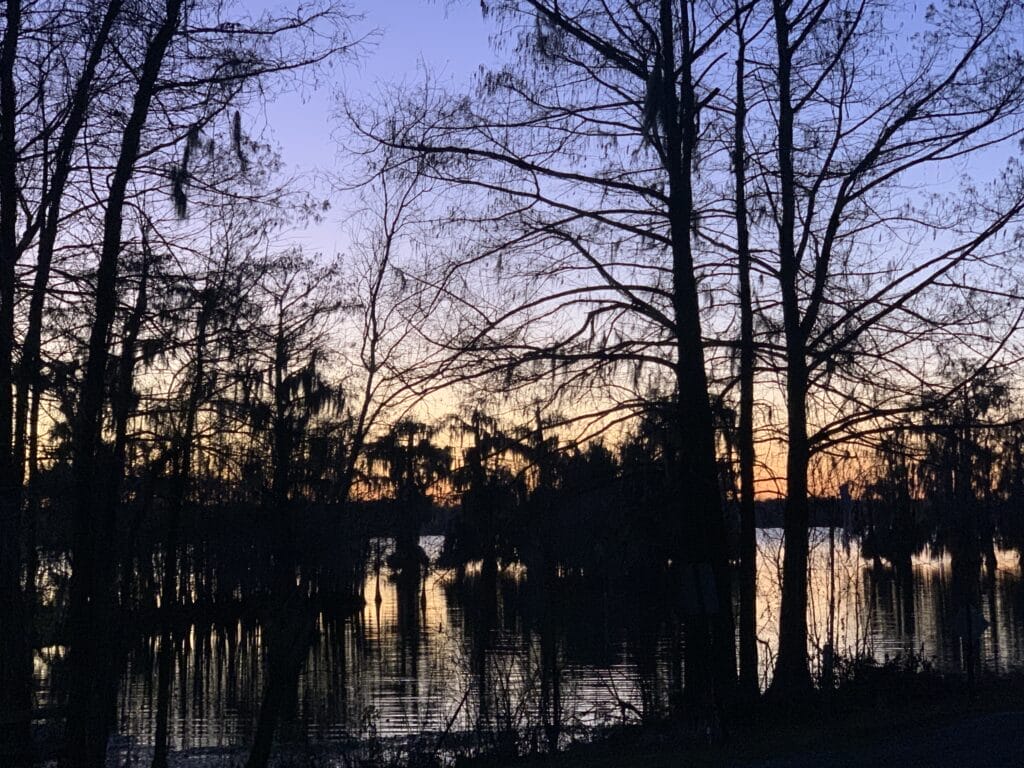
Save and Share this 12 Swamp Facts
The spark for our adventure through Louisiana’s swamps and learning surprising swamp facts ignited when my Louisiana-born brother-in-law suggested a swamp tour while we were in Lafayette.
Intrigued, we researched to find the perfect place, eventually stumbling upon the fascinating discussion, “The Great Swamp Tour Controversy”.
As this was the first swamp tour for us, we were grateful to have the information from the post.
We were able to make a conscious choice based on the consequences for the environment.
After careful consideration, we chose Champagne Cajun Swamp Tour, on Lake Martin, just east of Lafayette, in excitement, anticipating for an unforgettable experience.

Eco-Friendly Swamp Tour
We always prioritize minimizing our impact on Mother Nature wherever we go, and after our research, Champagne Cajun Swamp Tour meets our eco-friendly criteria.
The tour boats used have shallow bottoms, therefore minimizing disturbance of the natural floor of the swamp.
Our guide turns off the engine when we get to secluded areas of the swamp so as not to create noise pollution and interfere with the natural habitat as much as we can.
Another important factor to consider is that Champagne Cajun Swamp Tour does not feed the alligators with chicken or marshmallows to entice them to display themselves, as some other tours do.
I discussed this and it’s negative impact on my post, A Tranquil Day on Bayou Segnette. We appreciate Champagne Cajun Swamp Tour’s eco-friendly consciousness, and we hope you will consider these factors when searching for a swamp tour.
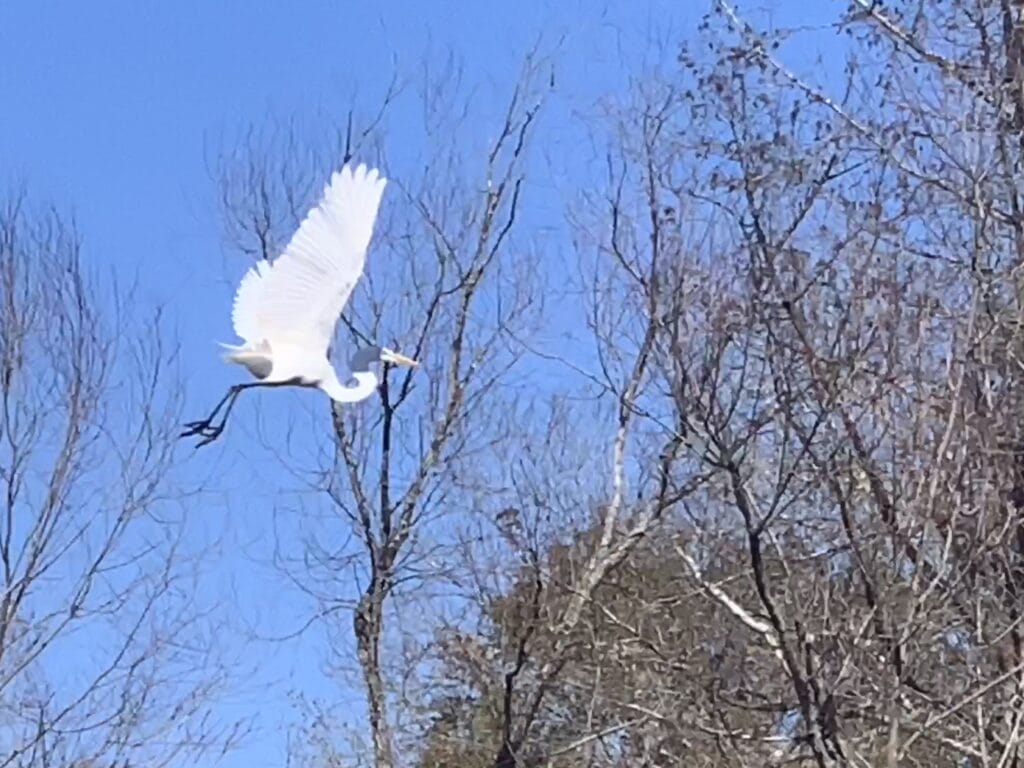
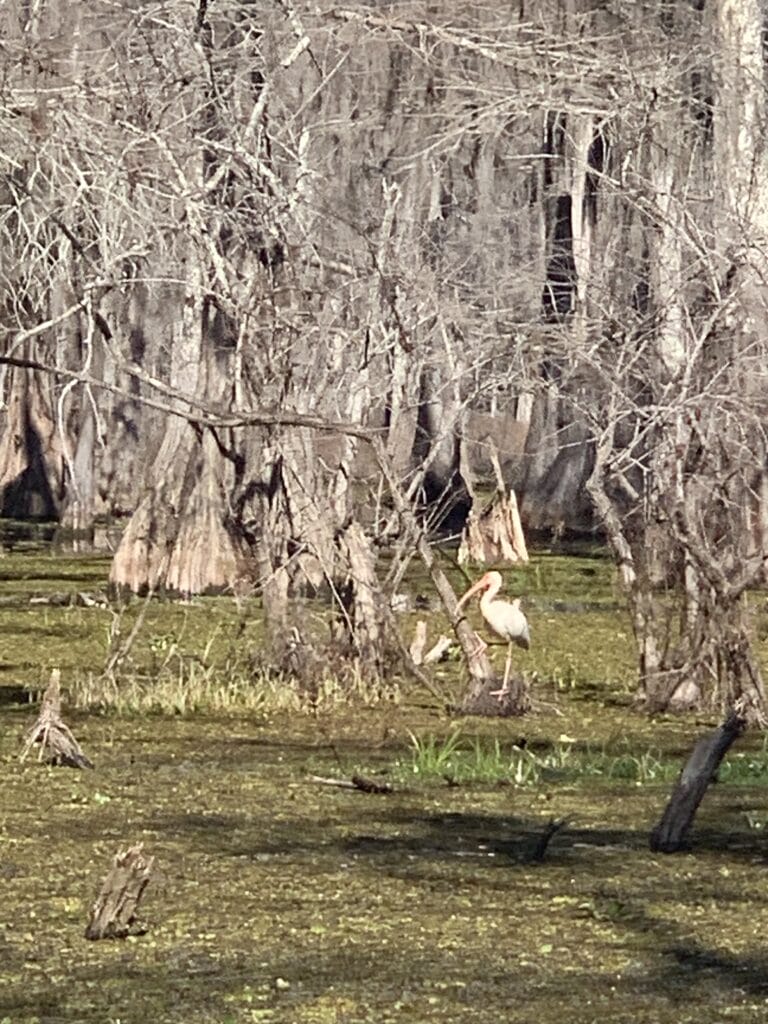
Surprisingly Beyond Our Expectations
Our journey through the hidden ecosystem full of life was unforgettable beyond our expectations.
The swamp revealed its lively inhabitants, from families of snapping turtles sunbathing on logs to a flurry of birds flocking the sky in every direction, transforming the surroundings into an aviary-like spectacle.
Some cypress trees adorned with 8 to 10 great white egrets resembled blooming flowers in the swamp’s unique ecosystem.
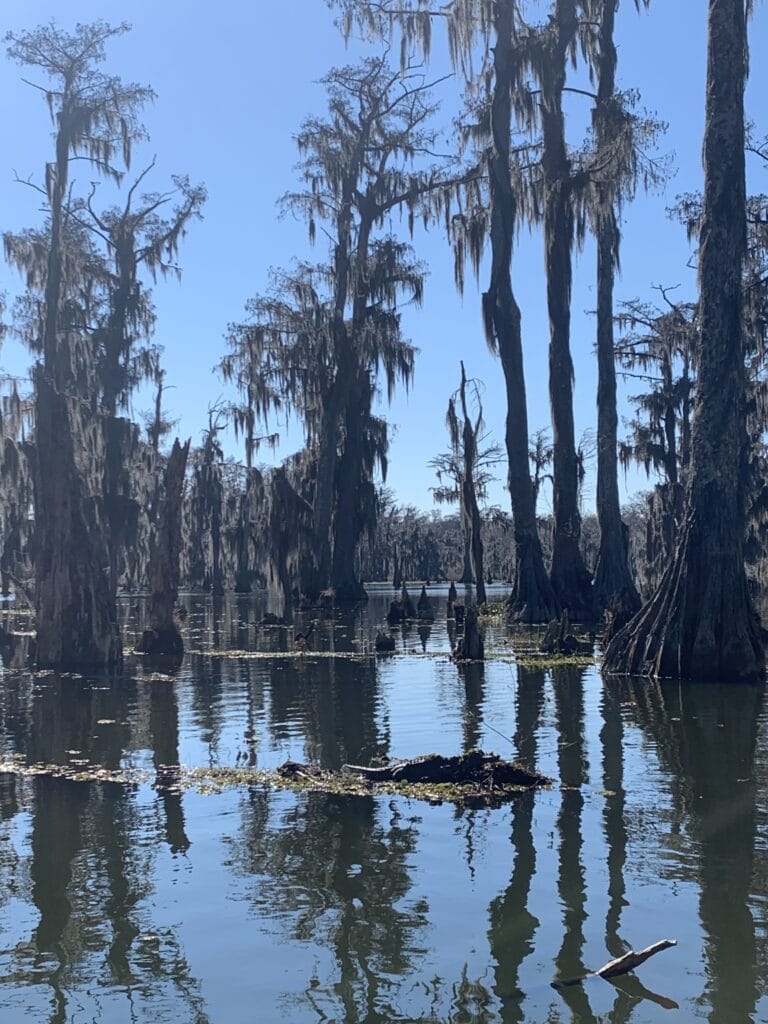
Even in this January winter chill, the swamp showed off its famous residents, including four teen and adult alligators and a not-so-clever camouflaged baby alligator sunbathing on logs.
Some people have reported seeing more than 40 alligators on this tour during the summer, when alligators are active and in full force.
I think our introduction to the swamp with four alligators is a great start.
And, most of all, manageable!
Up close and personal, the swamp was pulsing with lively energy. It was truly magical.
Champagn Cajun Swamp Tour Experience
Champagne Cajun Swamp Tour is a host on Harvest Host, a membership program that allows RV travelers to park overnight at unique business facilities.
Ron, whom I believe is the owner, generously extended warmth to us as non-members, welcoming us to park and stay overnight on his picturesque lake-view property.
Waking up to that view on the tour day was absolute bliss.
Our guide, with that charming southern accent, turned every detail into a chapter in a captivating story.
And decoding that accent?
Well, let’s say it added an extra layer of adventure to the adventure.
We learned that the swamp is more than just a flooded forest; it’s a lively ecosystem with fascinating and surprising facts!
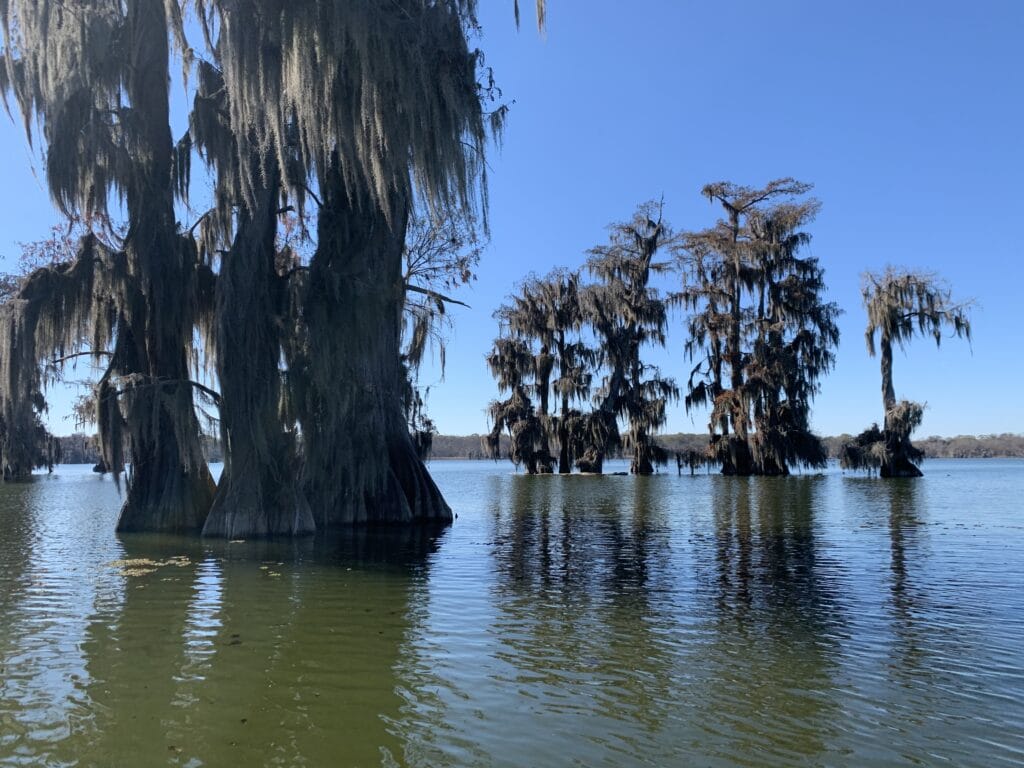
12 Surprising Fun Swamp Facts
1. Swamp Origins:
The term “swamp” literally means a “flooded forest.” Swamps have diverse origins influenced by geological, climatic, and ecological factors. They play crucial roles in supporting unique ecosystems, providing habitat for various species, and contributing to the overall health of the environment. Distinguishing itself from a marsh, which is characterized by tall grass and mud, and a bayou, a slow-flowing river, the swamp embodies a unique blend of submerged woodlands and aquatic life.
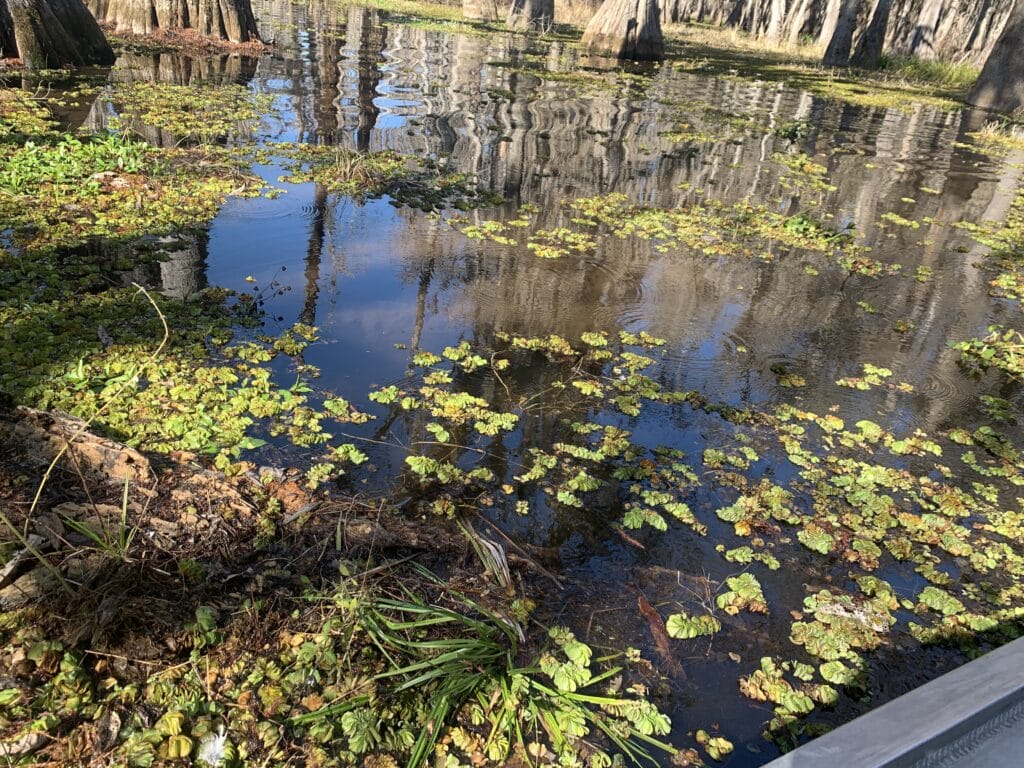
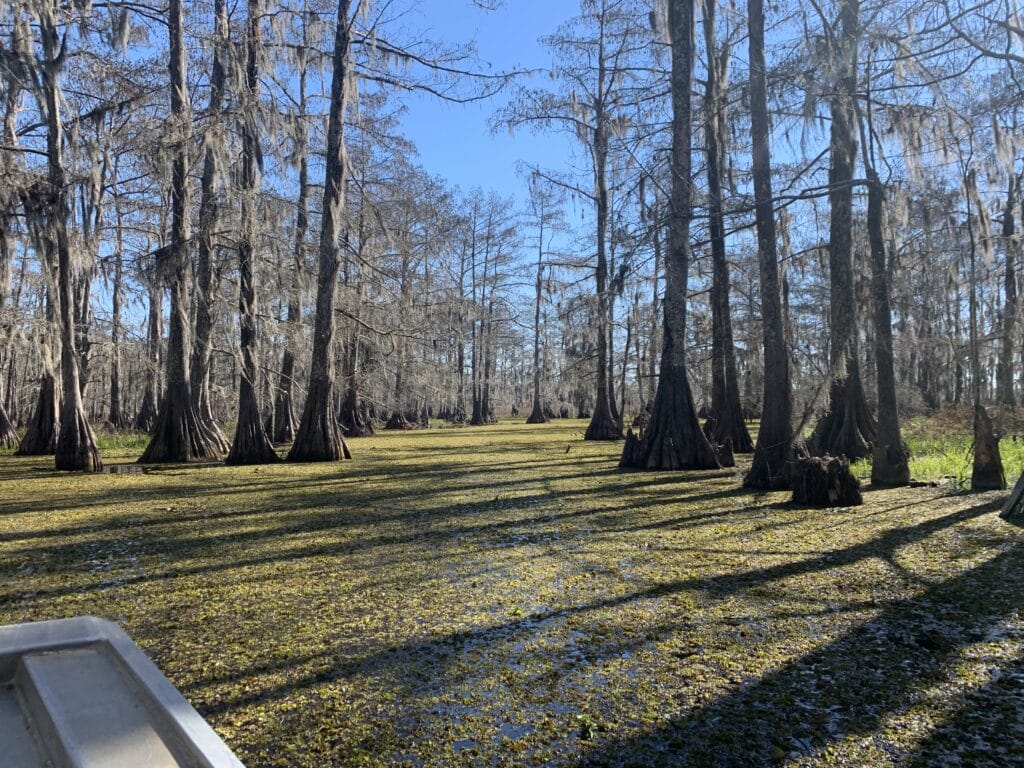
2. Pristine Waters:
The swamp’s water maintains its purity through the natural filtration provided by aquatic plants, including hydrilla. These plants play a vital role in improving water quality by absorbing excess nutrients. Meanwhile, the decomposition of organic matter, such as fallen leaves and plant debris, sustains the nutrient cycle within the swamp. This cycle supports a rich diversity of plant and animal life, contributing to the overall health of the ecosystem.
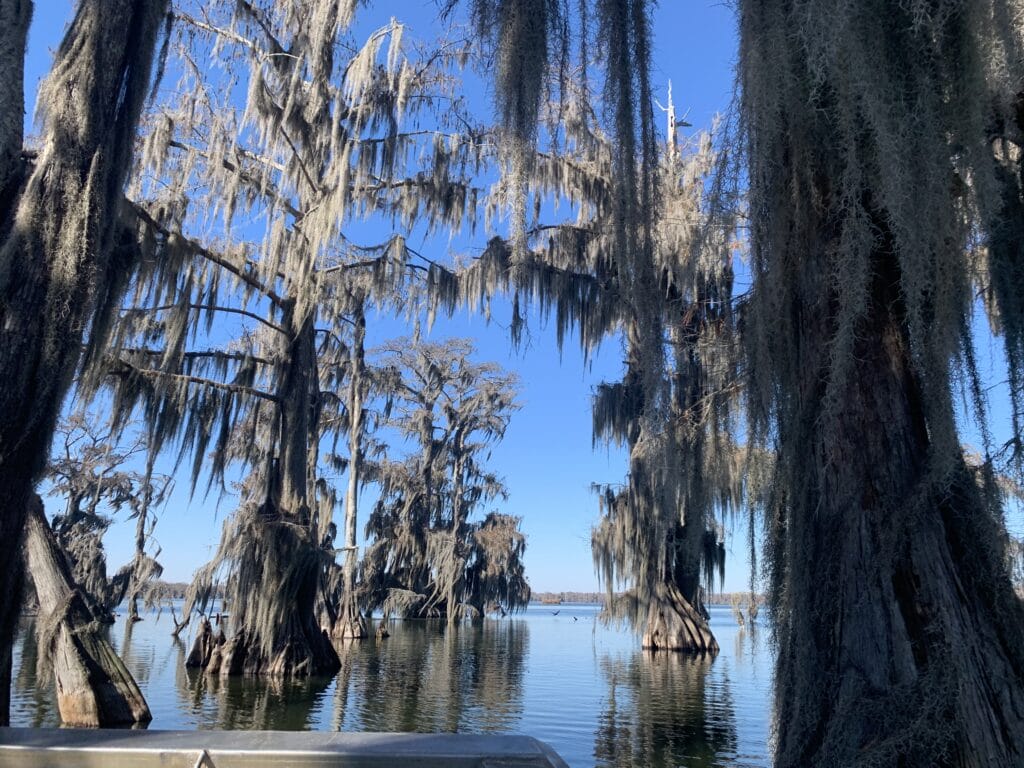
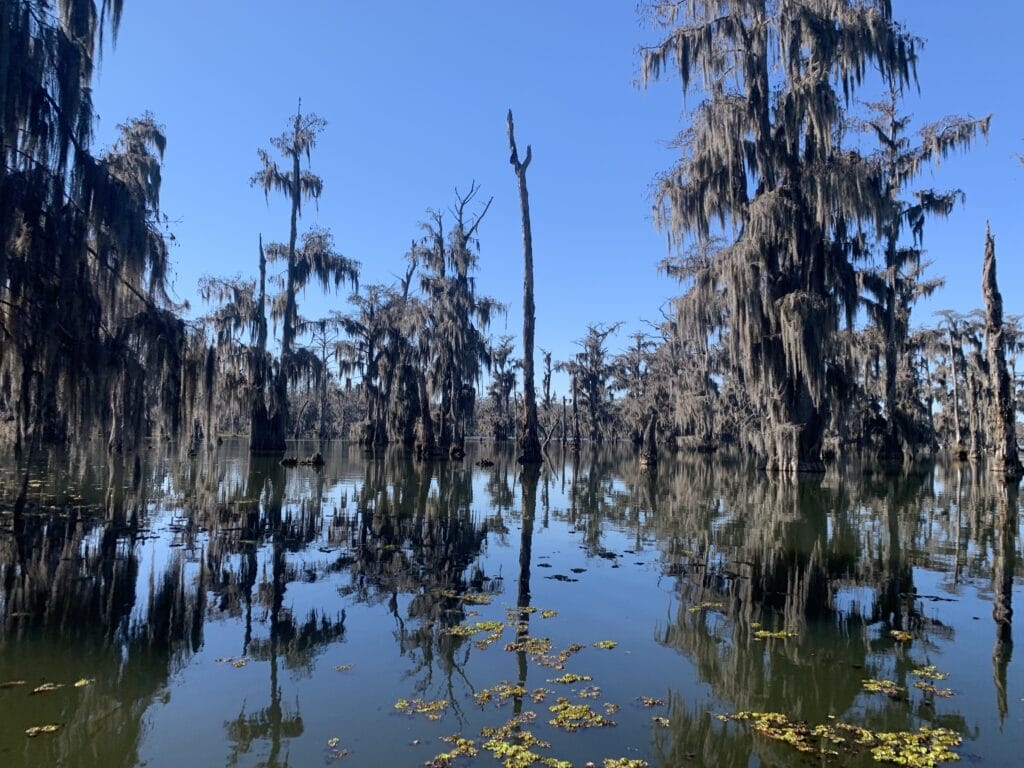
3. Spanish Moss Wisdom:
Spanish moss, the intriguing plant that drapes itself over trees, giving a mystical and aged quality to the trees, is a common sight in swamps. Contrary to appearances, they do not impede tree growth. Instead, it uses the tree for support. It relies on rain, air, and nutrients from the atmosphere for sustenance, aiding the trees and helping them retain moisture.
4. Mosquito-Repelling Tupelo Gum Surprise:
The tupelo gum tree, with its unique qualities, serves as a natural mosquito repellent, according to our guide. He brought up that Lake Martin rarely has mosquitoes due to the leaves of the Tupelo gum tree falling into the swamp water as an effective mosquito repellent. I couldn’t find this information anywhere else on Google. So, is this fact or fiction? Any takers?
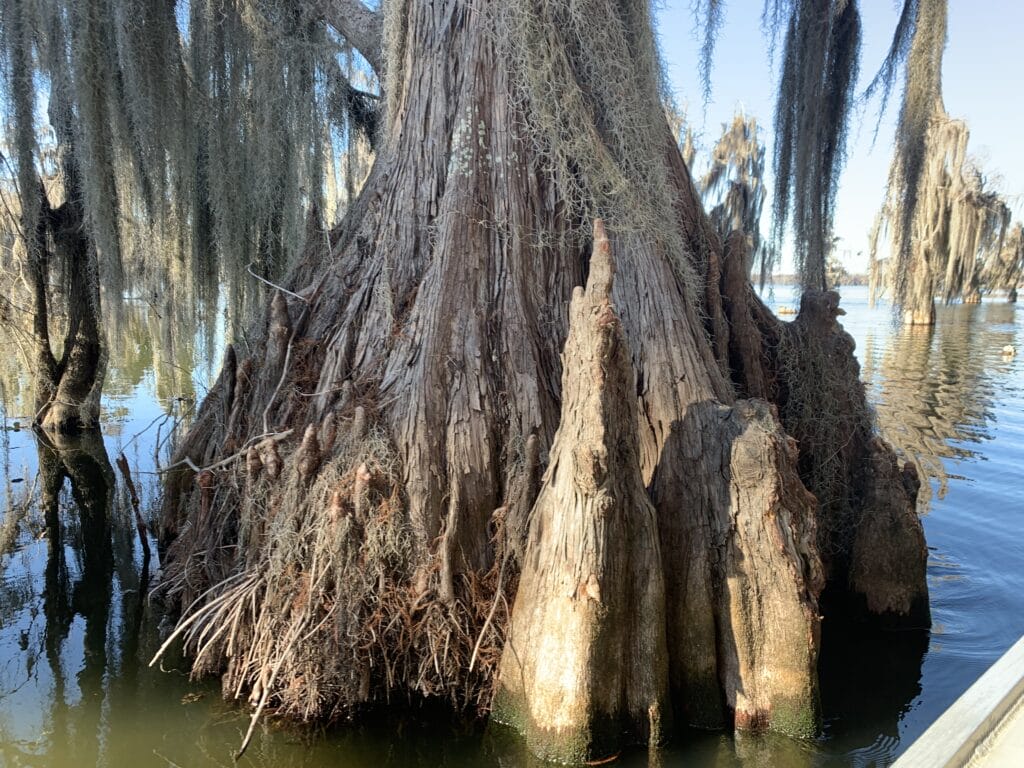
5. Roots and Stability:
Swamp trees, particularly the majestic bald cypress, have roots as deep as the tree’s height above the water. They can reach heights of 100–150 feet. Can you imagine their roots reaching 100–150 feet below ground? These extensive roots provide essential stability during hurricanes. “Cypress knees,” or little bark hoodoos that grow from the trees’ roots and stick out above the water, are thought to also help stabilize the tree against hurricane-force winds.
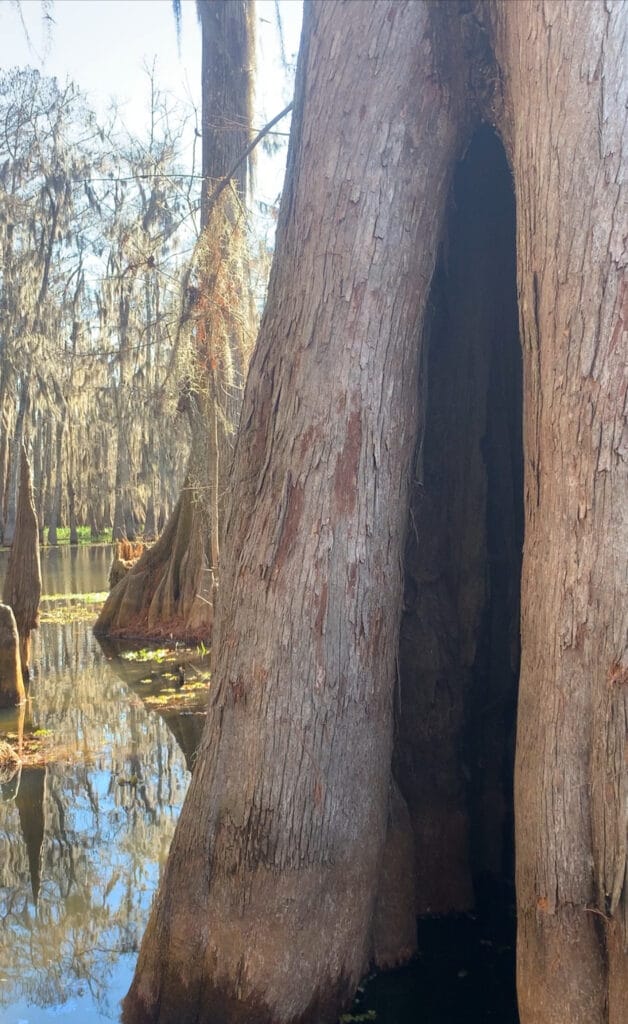
6. Timeless Cypress Trees:
The bald cypress tree is the state tree of Louisiana and can grow for thousands of years. As they mature, they develop hollow trunks near their bases. This isn’t a sign of weakness; instead, it’s a strategic design by Mother Nature, providing shelter for mammals during hurricanes.

7. Life Surviving Lichen Navigation:
In addition to all the uses of lichen by the Natives, navigating in the wilderness was one. According to our guide, Natives used the growth patterns of lichen on trees as a guide in the past, as pink lichen exclusively grows on the north side of these trees.
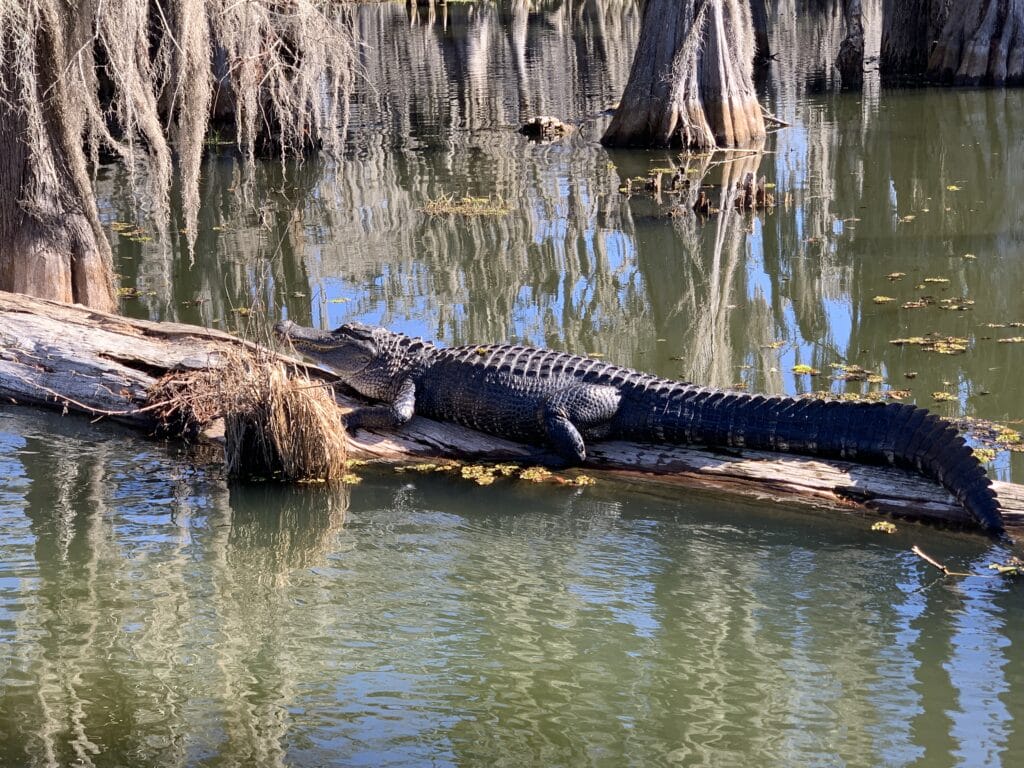
8. Alligators, Not Crocs:
In Louisiana’s freshwater swamps, it’s alligators that rule. Unlike crocodiles, which prefer saltwater, these fascinating creatures remain inactive in colder weather and become sunbathing aficionados when the temperatures rise. However, on that first scorching day, crossing the 90-degree Fahrenheit mark, the swamps come alive, transforming seemingly sluggish reptiles into zooming speedboats. I would love to see this scene…from a distance, that is.
9. Survival of the Hatchlings:
Newly hatched alligator babies face a survival rate of only 30%. Their nests are threatened by flooding and different predators, such as red ants. The average clutch size of an alligator nest is 38, and 24 live hatchlings will emerge at about 8 inches long. Out of the hatchling, 10 alligators will live to be one year old. Of these survivors, eight will become semi-adults 4 feet in length.
10. Muddy Origins:
The primitive forms of land, as we know them, emerge from the mud in swamps. Decomposing vegetation in the mud gives rise to the very foundations of terrestrial life.
11. Methane Facts:
Seeing bubbles gracefully ascending from the swamp’s shallow depths is an intriguing phenomenon. These bubbles, a byproduct of decomposing vegetation at the bottom, release methane, adding to the fascination of the swamp’s unique environment.
12. Woodpeckers and Wood Ducks:
Woodpeckers play a crucial role in the swamp ecosystem. Their abandoned nests become homes for wood ducks, continuing the cycle of life in this vibrant environment.
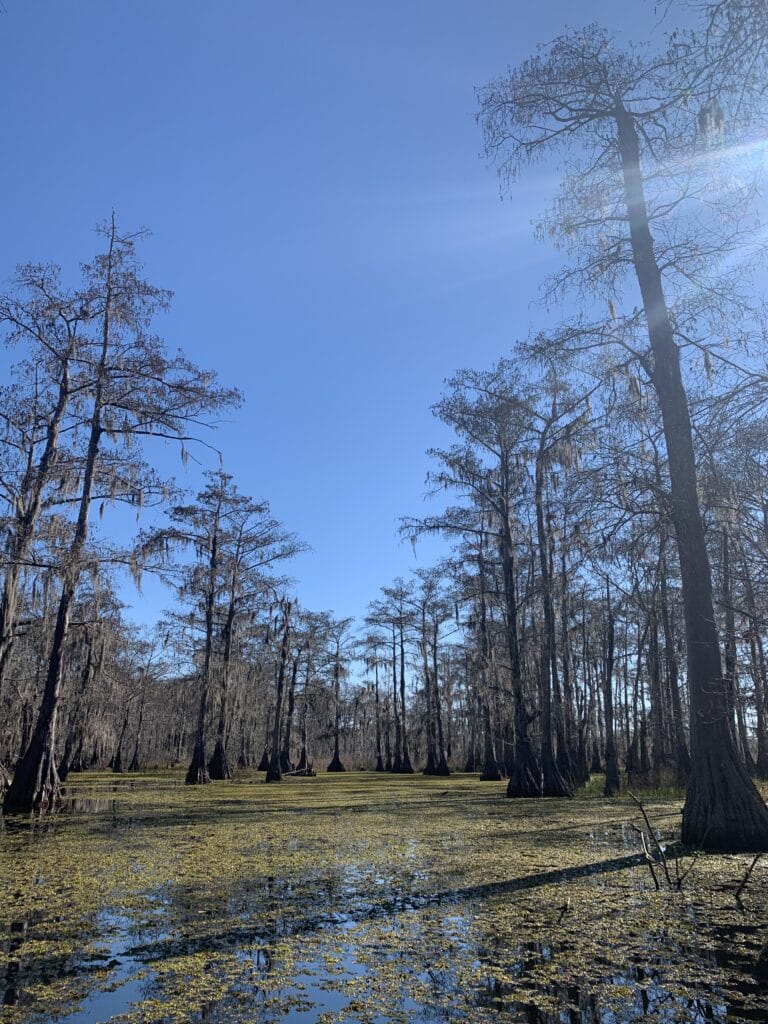
Nature has meticulously crafted this intricate ecosystem, where each element plays its part, creating a flawless whole.
Not knowing what to expect before the tour as a non-swimmer, the tour guide brought me some delight when he mentioned that if we fall out of the boat during the tour… just stand up.
The depth of the swamp is merely 3 feet!
Final Thoughts on Swamp Facts
The 12 fun and surprising swamp facts in Louisiana discussed here are what make this nature sanctuary so perfect.
With each story told and every turn we made, I felt this profound sense of wonder and satisfaction.
Leaving the swamp, its magic stayed within me, a tribute to the simple bliss of ‘dolce far niente’ in nature.
This journey is a chapter etched in me, forever echoing with the bliss of the swamp’s unique charm.
Life’s good when you’re taking a stroll in Mother Nature’s gallery in an eco-friendly way, don’t you think?
Have you experienced the swamps and do you have any other fun facts to share? Please let us know below.
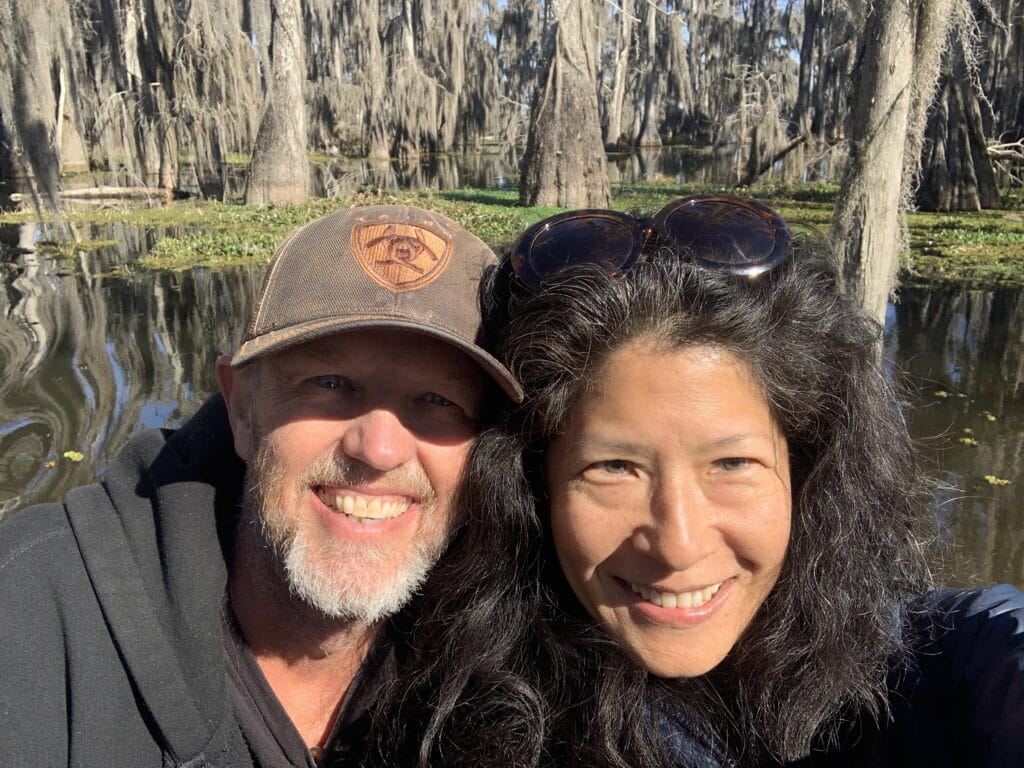
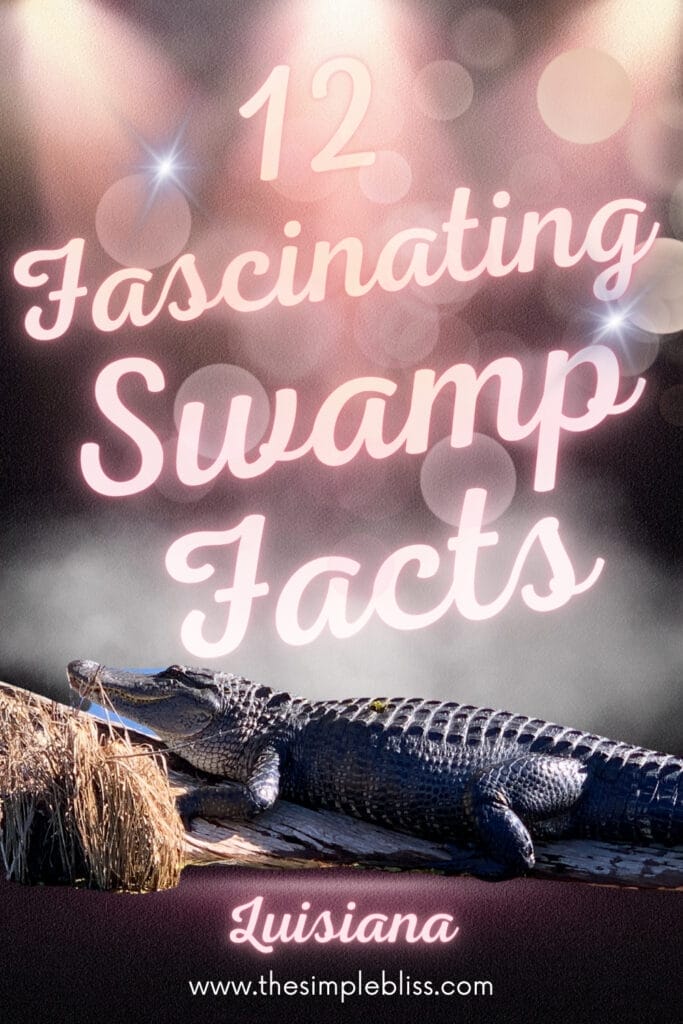



Leave a Reply